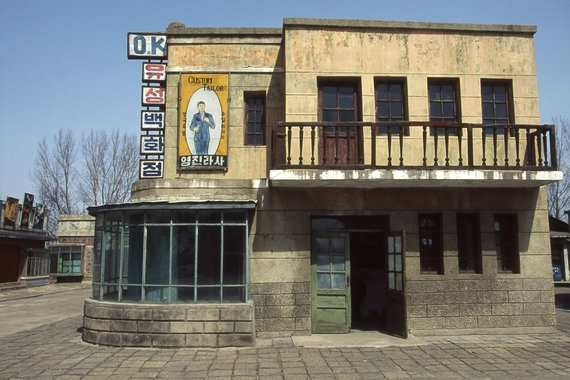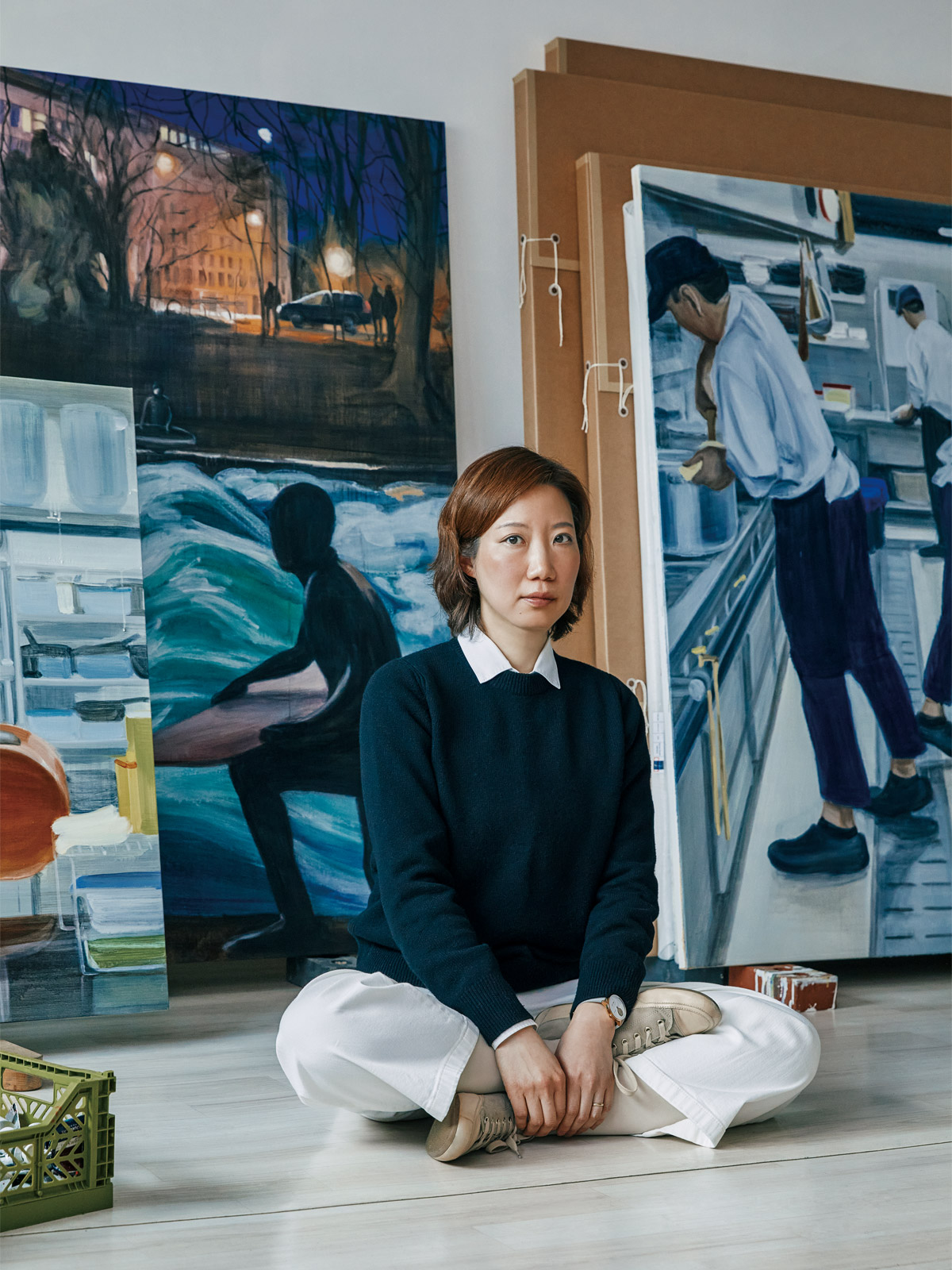Park
Chan-kyong (b. 1965), a media artist, filmmaker, and writer, has explored
themes such as the Cold War, division, tradition, and religion, examining
Korean society’s reckless pursuit of Western-style modernization and economic
growth.
Before
becoming an artist, Park wrote about art and curated exhibitions. He also
collaborates with his brother, film director Park Chan-wook, as the media
artist duo "PARKing CHANce."

Park Chan-kyong, Sets, 2000 ©REAL DMZ PROJECT
Starting with his first solo
exhibition "Black Box: Memory of the Cold War Images" at the Kumho
Museum of Art in 1997, Park has presented photography and video works that
address Korea’s division and the Cold War, often focusing on their relationship
with mass media and political psychology.
For example, Sets
(2000) is a slideshow of 160 photographs of sets built in both South and North
Korea, including those of the North Korean Film Studio mimicking buildings and
streets in Seoul, a set designed in South Korea for urban warfare scenes, and
images of the movie set for Joint Security Area (JSA),
which accurately recreated the DMZ’s Panmunjom.
The artificial arrangement of these
photographs breaks down the geographical context of real places, making it
difficult for viewers to distinguish time and space.

Park Chan-kyong, Flying, 2005 ©REAL DMZ PROJECT
In June 2000, the first inter-Korean
summit was held since the Korean War, establishing the first direct air route
between the North and South. Park created Flying
(2005), a 13-minute video edited from footage of President Kim Dae-jung’s
one-hour flight to meet North Korea’s leader Kim Jong-il, interspersed with
images of the Korean War.
The video’s soundtrack features the
opening of Isang Yun’s Double Concerto, composed with
the hope of reunification. Flying juxtaposes
images of North Korean villages, airports, and crowds, revealing a scene of the
divided Korean Peninsula as it shifts between Cold War and post-Cold War
tensions.
 Park Chan-kyong, Sindoan,
2007 ©Kukje Gallery
Park Chan-kyong, Sindoan,
2007 ©Kukje GalleryIn his 2008 solo exhibition "Shindoan" at Atelier Hermès, Park began a new phase of work reflecting on Korea’s distorted modernization and contemporary society through Korean folk religion and shamanism.

Installation view of “Park Chan-kyong: Sindoan” in 2008 ©Atelier Hermès
The exhibition featured a 45-minute
documentary video Sindoan (2007), which explores the
past and present of Sindoan, a sacred area in Namsan-myeon, Gyeryong-si,
Chungcheongnam-do, long a site of Korean folk religion. The exhibition also
included archival photographs and architectural models.
The artist began by re-examining
Sindoan, a site that has been continually repressed from the Joseon Dynasty
through the Japanese colonial period and into modern times. The work highlights
Korea’s history and attitudes toward the ‘Gyeryongsan Culture,’ a local religion
often dismissed as a cult, and examines the fear and rejection of superstitions
while reconstructing Korea’s distorted modern history.
 Park Chan-kyong, Manshin,
2014 ©Kukje Gallery
Park Chan-kyong, Manshin,
2014 ©Kukje GalleryThis reflection on modernity and present through folk religion and shamanism continued with works like Anyang, Paradise City (2010), Manshin: Ten Thousand Spirits (2014), Citizen's Forest (2016). Among these, Manshin, which tells the story of Korea’s modern history and healing through the life of shaman Kim Geum-hwa, was released in theaters.
 Installation view
of Citizen’s Forest
at Kukje Gallery in 2017 ©Kukje Gallery
Installation view
of Citizen’s Forest
at Kukje Gallery in 2017 ©Kukje GalleryCitizen’s Forest is a three-channel video-audio piece, spread out like a traditional Korean landscape painting, offering a critical reflection on Korea’s modern history and mourning the countless unnamed individuals sacrificed in times of upheaval. The figures marching through the mountains in the work represent the victims of tragic historical events such as the Donghak Peasant Movement, the Korean War, the Gwangju Uprising on May 18, and the Sewol Ferry disaster.
 Installation
view of Citizen’s
Forest
at Kukje Gallery in 2017
©Kukje
Gallery
Installation
view of Citizen’s
Forest
at Kukje Gallery in 2017
©Kukje
Galleryinspired by two works: the poem Colossal Roots (1964) by Kim Soo-young (1921 – 1968) and the painting The Lemures (1984) by Oh Yoon (1946 – 1986), Park created Citizen’s Forest as a commentary on the irreversibility of history, no matter how tragic, and a consolation for the nameless victims of Korea’s modern era, while also exposing the limits of Korea’s unresolved modernity.

Park Chan-kyong, Belated Bosal, 2019 ©MMCA
In his
2019 Hyundai Motor Series exhibition at the National Museum of Modern and
Contemporary Art Korea, Belated
Bosal
depicted modern-day disasters through episodes drawn from Buddhism in a
black-and-white negative film.
Set in a
radioactive area, the film features a protagonist measuring radiation levels in
the mountains who later sees her past life at a temple, alongside young people
drawing and making objects, and a ‘Bosal.’ The interplay of images involving
nature, Buddhist myths, nuclear power plants, and art seems disconnected yet
produces a subtle friction. Through this, Park symbolically portrays a society
that has lost its coherence.

Installation view of “MMCA Hyundai Motor Series 2019: Park Chan-kyong – Gathering” ©MMCA
By looking to the past, Park continues to re-examine the present. His work uncovers distorted points in history, offering comfort to marginalized figures, and through this, he urges us to re-confront our present and consider the future.

Artist Park Chan-kyong ©Kukje Gallery
the
California Institute of the Arts with a MFA in Photography in 1995. Park served
as the Artistic Director of the SeMA Biennale Mediacity Seoul in 2014.
Park’s
work has been exhibited internationally in numerous solo and group exhibitions
including Haus der Kulturen der Welt, Berlin (2017), Taipei Biennial (2016),
Anyang Public Art Project (2016), Iniva, London (2015), Art Sonje Center, Seoul
(2013), and Atelier Hermès, Seoul (2008, 2012). Park was
awarded the Hermès Korea Art Award in 2004, and the Golden Bear for best short
film at the Berlin International Film Festival in 2011 for Night Fishing.
His
works are included in the collection of major art institutions, such as the
National Museum of Modern and Contemporary Art, Korea; KADIST, Paris and San
Francisco; Musée des Beaux-Arts de Nantes, Nantes; Leeum, Samsung Museum of
Art, Seoul; Seoul Museum of Art; Gyeonggi Museum of Modern Art, Ansan; and Art
Sonje Center, Seoul.
References
- 국립현대미술관, MMCA 현대차 시리즈 2019: 박찬경 – 모임 (National Museum of Modern and Contemporary Art Korea (MMCA), MMCA Hyundai Motor Series 2019: Park Chan-kyong – Gathering)
- 리얼디엠지프로젝트, 박찬경 (REAL DMZ PROJECT, Park Chan-kyong)
- 아뜰리에 에르메스, 신도안 (Atelier Hermès, Sindoan)
- 국제갤러리, 안녕 安寧 (Kukje Gallery, Farewell)
- 국립현대미술관, 박찬경 | 시민의 숲 | 2016 (National Museum of Modern and Contemporary Art Korea (MMCA), Park Chan-kyong | Citizen’s Forest | 2016)




















